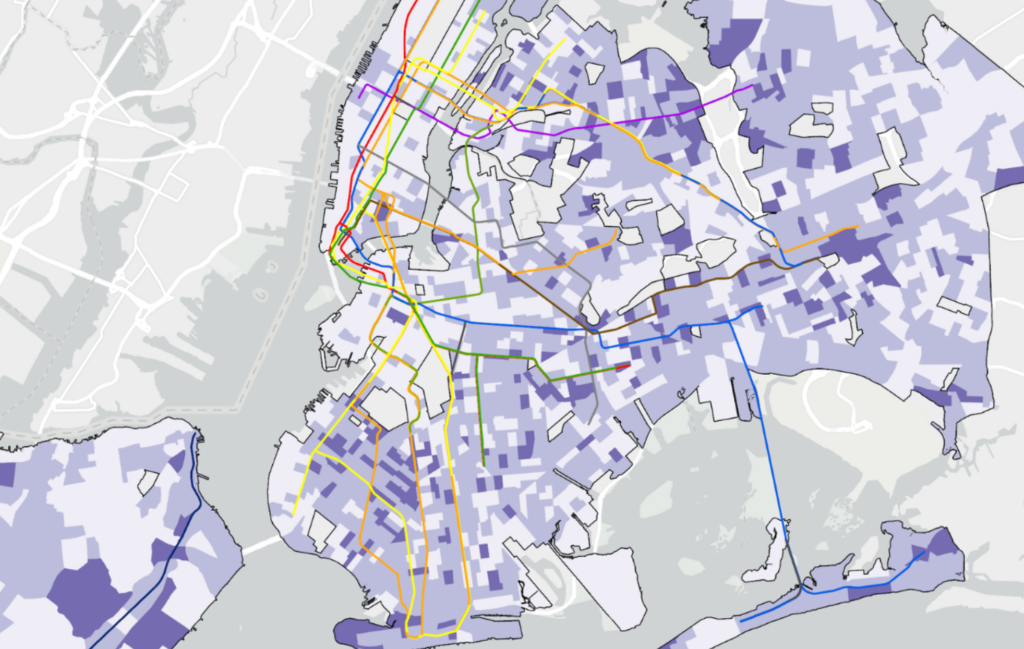Mapping transit affordability for 415,000 New Yorkers
Fair Fares is a crucial lifeline of affordability for over 360,000 New Yorkers currently enrolled in the program. First launched in 2019, Fair Fares offers half-fare subway, bus, and paratransit rides to low-income New Yorkers ages 18-64. The program began with an income limit of 100% of the Federal Poverty Level (FPL), which was expanded to 120% of the FPL in 2023, and 145% of the FPL in 2024. While these expansions are welcome steps in the right direction, expansion to 200% of the FPL will ensure that all low-income New Yorkers – including those making minimum wage, which currently excludes single individuals from the program – can benefit from Fair Fares. Half-price transit fares mean access to opportunity, employment, education, and more, but far too few people can qualify at the currently too-low eligibility threshold. No other city program has the power to improve transportation equity – and lives –while simultaneously addressing our city’s affordability crisis.
Expanding Fair Fares to 200% FPL will better serve the communities, particularly the working poor living paycheck-to-paycheck or making minimum wage, that need relief to make their commutes more affordable.
The program’s expansion to 200% from 145% would make more than 415,000 additional New Yorkers eligible, up from approximately 1.35 million who are eligible for Fare Fares today to over 1.75 million. Despite efforts to increase awareness and participation, only about 365,000 residents – or 27% of those eligible – are currently enrolled in the program – though research from the Community Service Society (CSS) shows that the true barrier to Fair Fares program success lies in its low eligibility threshold.
Expanding Fair Fares to the LIRR and Metro-North within New York City would also help break down barriers to transit access for New Yorkers around the five boroughs. Currently, the MTA’s commuter railroads provide faster access to Manhattan and other parts of the city than long subway and bus trips from Queens, Brooklyn, and the Bronx, but at $5 off-peak and $7 peak, these faster trips are unaffordable to many working-class riders. Expanding Fair Fares to the LIRR and Metro-North within New York City would ensure that more low-income New Yorkers can benefit from the commuter rail network that runs through their backyards, particularly in subway deserts. This change would be particularly impactful for areas of Southeast and Northeastern Queens, the Central and Western Bronx, and, eventually, the Eastern Bronx after the completion of four new Metro-North stations that will be constructed by 2027 as part of the Penn Station Access project.
PCAC, in collaboration with New York City Council Speaker Adams, the CSS, and Riders Alliance, has advocated for the much-needed expansion of the Fair Fares program through research, op-eds, and campaigns to support the increase to 200% of FPL since prior to the inception of the program. This city-funded program would require an additional $36-$40 million a year in funding, per CSS analysis. In the FY2025 budget year, Fair Fares received $95 million in annual baselined funding from the city, with $25 million of that funding currently unused due to under-enrollment. The FY2026 City Council budget proposal suggests adding an additional $60.8 million of baselined annual funding to bring the total funding up to $157.1 million and fund the eligibility expansion to 200% of the FPL.
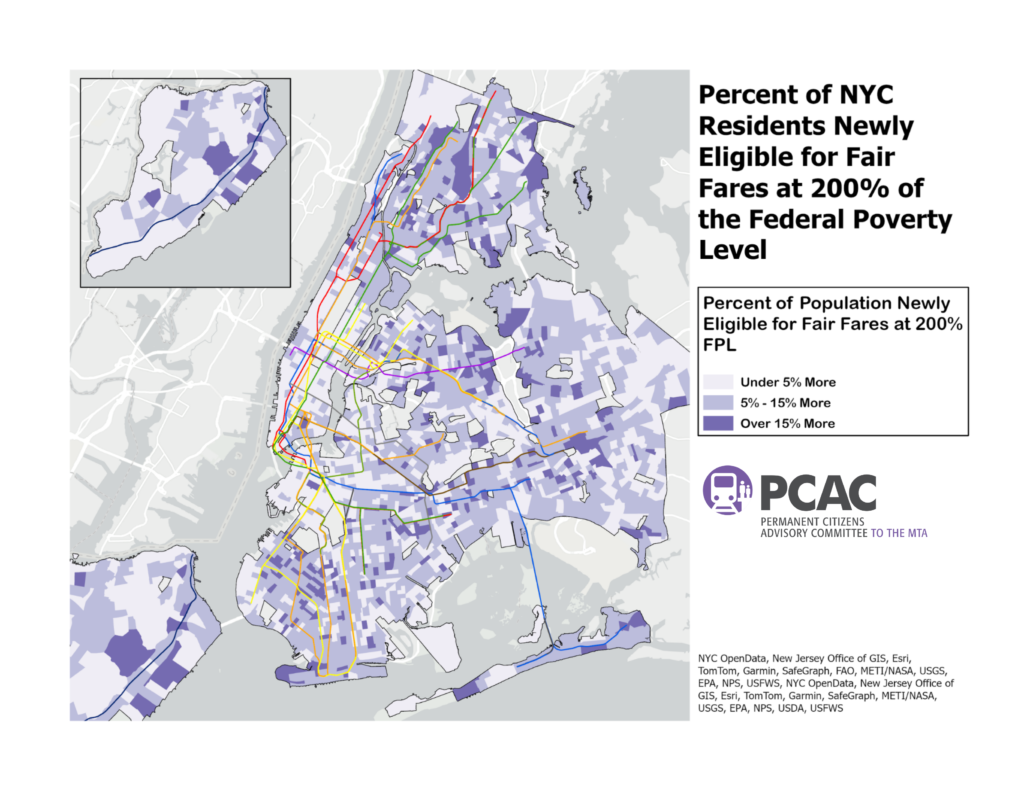
As noted in the 2023 report of the Blue-Ribbon Panel on Fare Evasion, the program is also a critical tool to make subways and buses more equitable while reducing fare evasion. Key to improving its reach, the panel recommended raising the income eligibility threshold to 200% of FPL, as well as giving residents who receive fare evasion summonses the opportunity to enroll in the program. That recommendation has been implemented.
PCAC analyzed how an expansion of Fair Fares to 200% from 145% FPL would benefit New Yorkers around the city and which boroughs and districts would see the greatest increase in eligible residents. PCAC used American Community Survey data from 2019-2023 broken down by census tract, City Council district, State Senate District, and State Assembly district to show where riders ages 18-64 are most impacted by the current too-low eligibility threshold.
Key Findings of Expansion to 200% FPL from 145%:
- Over 415,000 New Yorkers will become eligible for the program, including over 160,000 regular commuters.
- 42 of 51 Council districts would see at least 1,500 more commuters newly eligible for Fair Fares.
- Every Senate district outside of central Manhattan would see at least 2,500 commuters become newly eligible.
- The majority of Upper Manhattan and Assembly districts outside of Manhattan would see at least 2,000 newly eligible commuters.
- The Bronx will see the greatest per capita increase, as an additional 10.17% of the 18-64 population will become eligible for Fair Fares. Queens and Brooklyn are second and third at 8.46% and 8.25% respectively.
- Brooklyn will see the greatest increase in total population over those now eligible for Fair Fares at nearly 134,000 people, followed by Queens at 123,000, The Bronx at 86,000, Manhattan at 54,000, and Staten Island at 20,000.
- An expansion of the program would have the greatest impact on working-class neighborhoods, including Sunset Park, Brownsville, Flushing, Elmhurst/Jackson Heights, Morrisania, and Highbridge.
- New York’s Fair Fares program has the most restrictive income requirements nationally, despite being the metro area with the highest cost of living and having the highest poverty rates of major cities with income-based fare discount programs.
Key Findings of Expansion to the LIRR and Metro-North within New York City:
- Expansion of the Fair Fares program to LIRR and Metro-North trains within New York City would provide access to a significant number of residents below 200% of the Federal Poverty Level, especially in portions of The Bronx and Queens that lack subway access.
- 35% of city LIRR and Metro-North stations are close to communities where over 60% of residents would qualify for Fair Fares at 200% FPL.
- 70% of city LIRR and Metro-North stations are close to communities where over 40% of residents would qualify for Fair Fares at 200% FPL.
- 90% of city LIRR and Metro-North stations are close to communities where over 20% of residents would qualify for Fair Fares at 200% FPL.
- In the Council districts containing LIRR and Metro-North stations in NYC, 143,567 potential LIRR and 160,892 potential Metro-North riders – a collective 304,459 –would qualify for Fair Fares at 200% FPL.
The Case for Expanding Fair Fares to 200% FPL
Slide the map below to see how many more neighborhoods would benefit from a higher Fair Fares eligibility threshold!
Figure 2 (Before): Concentration of NYC Residents Who Currently Qualify for Fair Fares at 145% FPL* vs. Figure 3 (After): Concentration of NYC Residents Who Would Qualify for Fair Fares at 200% FPL
*Note: Maps regarding change in Fair Fares eligibility use 150% of the Federal Poverty Level as a proxy for 145% of the Federal Poverty Level, due to the categorization used by the ACS and NHGIS in the dataset.
Where Residents Will Benefit from Fair Fares Expansion
While Fair Fares expansion will benefit New Yorkers around the entire city, certain neighborhoods will see particularly high rates of newly eligible residents. An expansion of the Fair Fares program from 145% to 200% of FPL will not be equally distributed across the city. Neighborhoods such as Sunset Park, Brownsville, Corona, Elmhurst/Jackson Heights, Morrisania, and Highbridge will see considerable increases in the number of residents that will be newly eligible for Fair Fares, while wealthier neighborhoods, including many neighborhoods in Manhattan, will see far more modest increases.
Figure 4: Fair Fares Eligibility by Borough
With expansion to 200% FPL, The Bronx will see the greatest per capita increase, with an additional 10.17% of the total population newly eligible for Fair Fares, while Queens and Brooklyn are second and third at 8.46% and 8.25% respectively. Brooklyn will see the greatest increase in total population over those now eligible for Fair Fares at nearly 134,000 people, followed by Queens at 123,000, The Bronx at 86,000, Manhattan at 54,000, and Staten Island at 20,000.
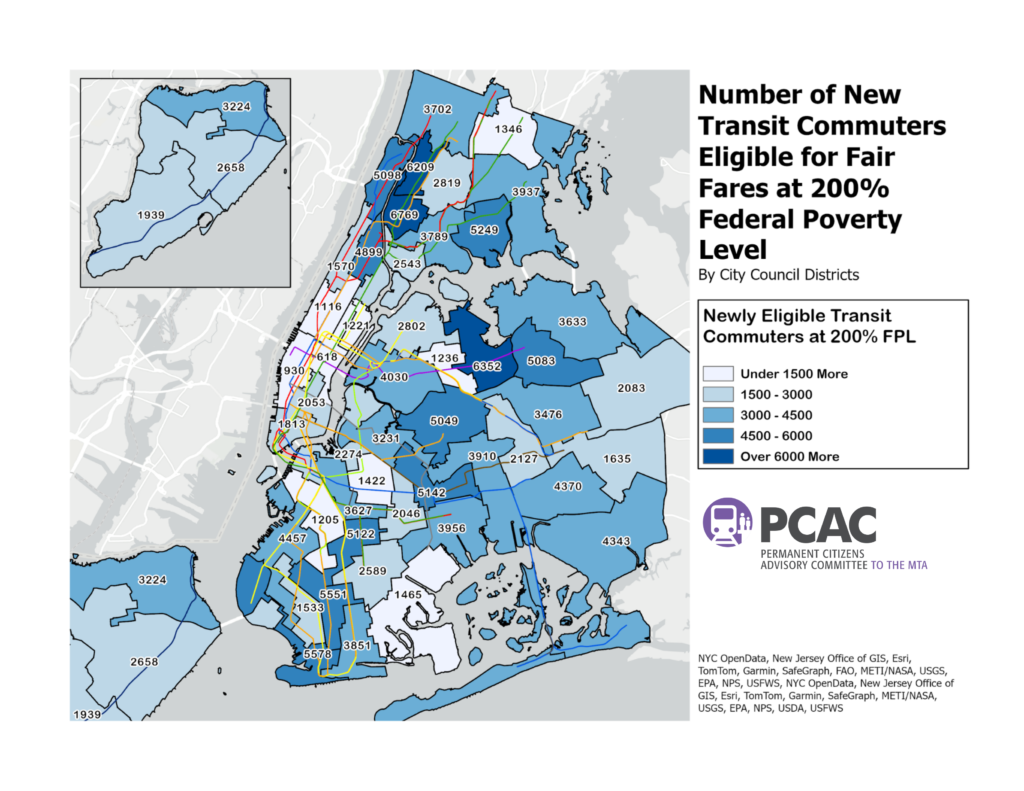


*Eligible commuting population was calculated by estimating that 40% of the 18–64-year-old population in each district will need to regularly commute.
The maps above show the increase in commuting population eligible for Fair Fares by Council, Senate, and Assembly districts. Districts in The Bronx, Queens, and South and Central Brooklyn would see the most significant increase in newly eligible residents. 42 of 51 Council districts would see at least 1,500 more commuters newly eligible for Fair Fares; every Senate district outside of Central Manhattan would see at least 2,500 commuters newly eligible; and the majority of Upper Manhattan and Assembly districts outside Manhattan would see at least 2,000 newly eligible commuters.
With Fair Fares expansion on the table at both the city and state level, it is a relevant issue for the dozens of local elected officials who represent New Yorkers.
The Case for Expanding Fair Fares to the LIRR and Metro-North within NYC
The map below shows how the expansion of the Fair Fares program to LIRR and Metro-North trains within New York City would expand access to a significant number of residents below 200% of the federal poverty level, especially in portions of The Bronx and Queens that do not have easy subway access. 90% of city LIRR and Metro-North stations are close to communities where over a fifth of residents would qualify for Fair Fares at 200% of FPL and many stations in Brooklyn, Queens, and The Bronx are close to communities where over 60% of residents would quality. Expanding Fair Fares to LIRR and Metro-North within New York City would be a boon for transportation equity in the city, helping to ensure that all New Yorkers can afford the fastest, most convenient transit option available to them regardless of income.
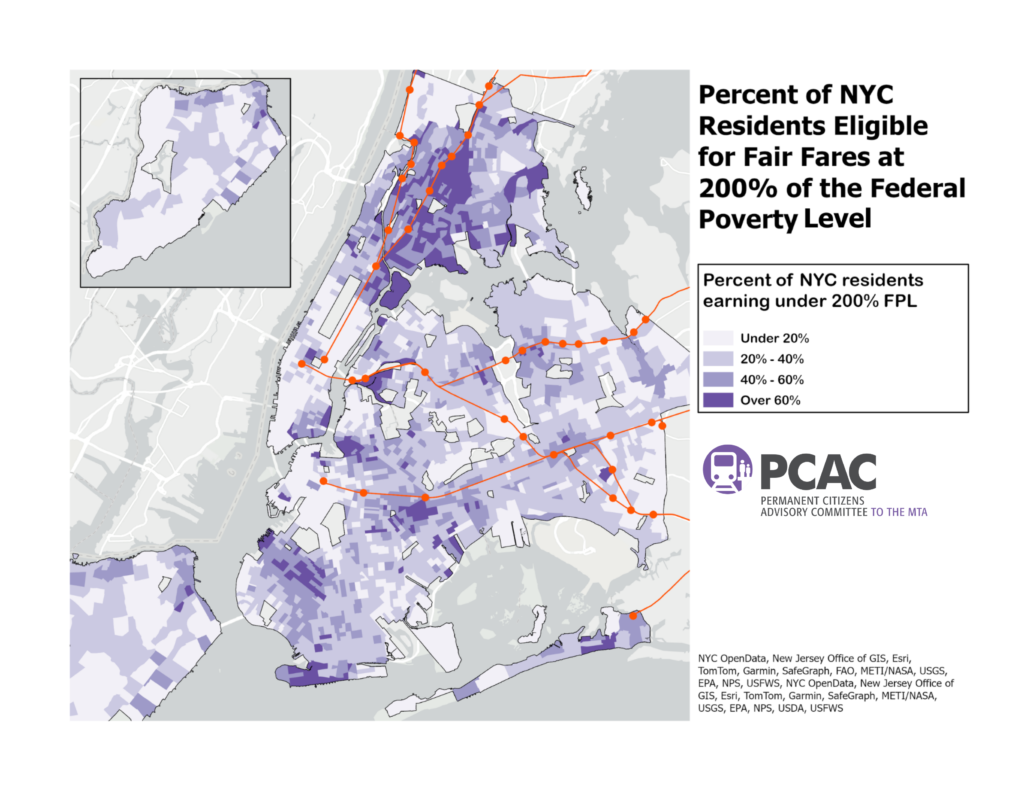

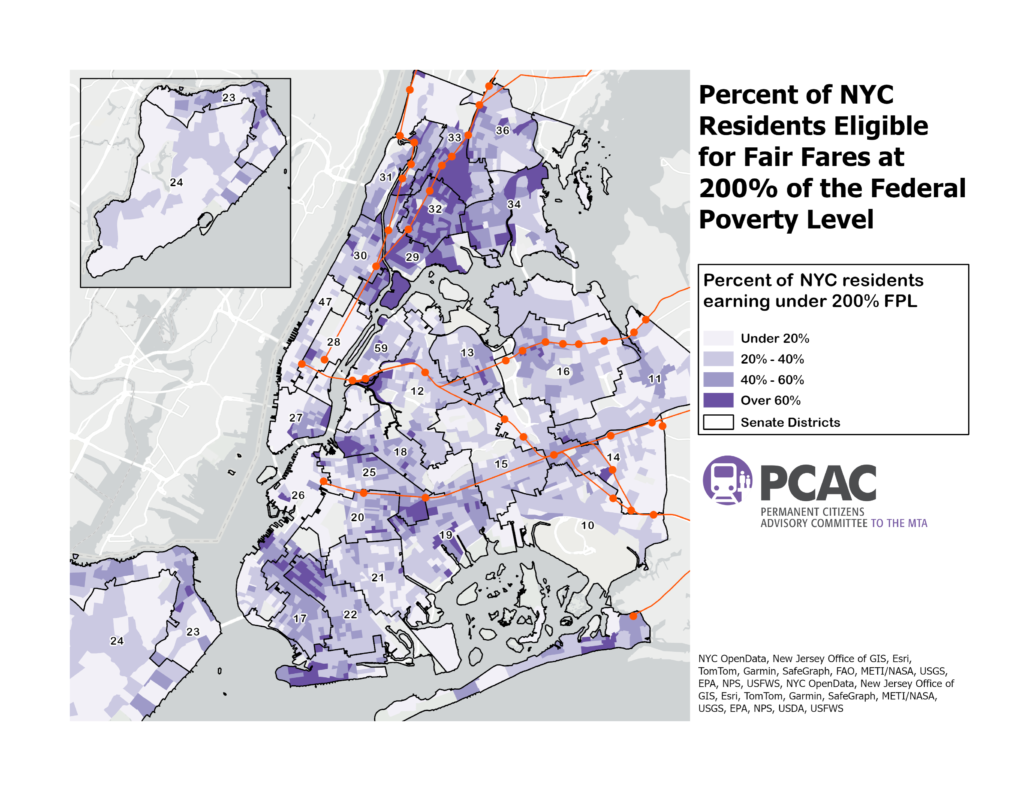
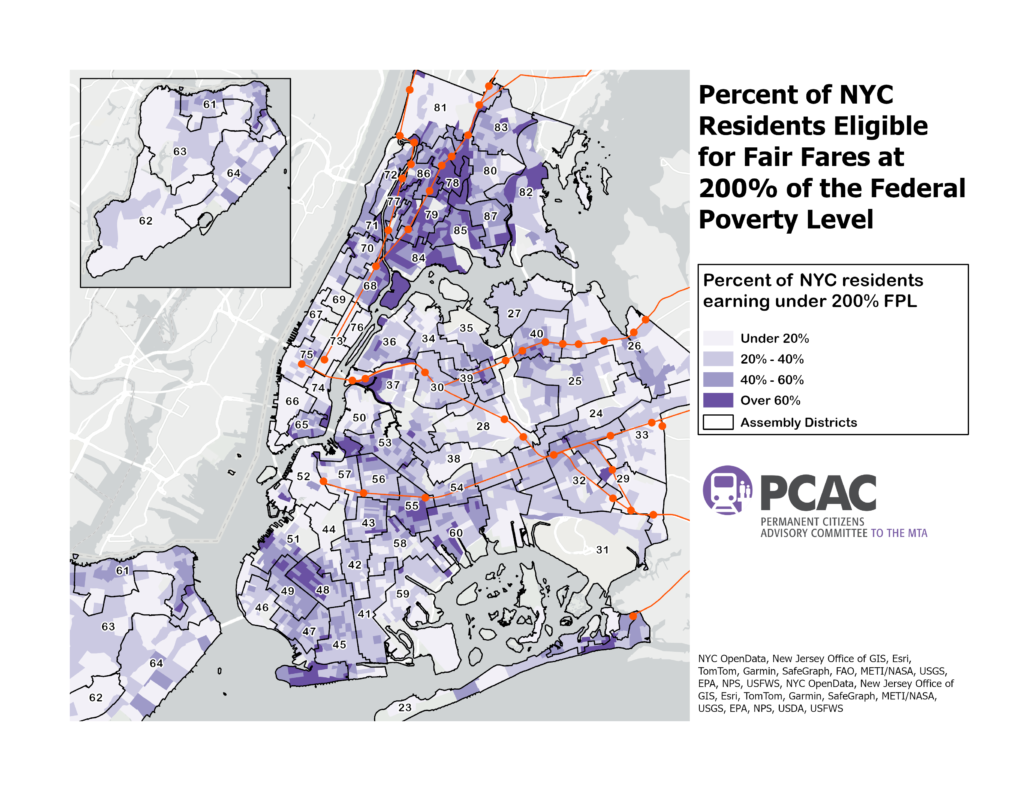
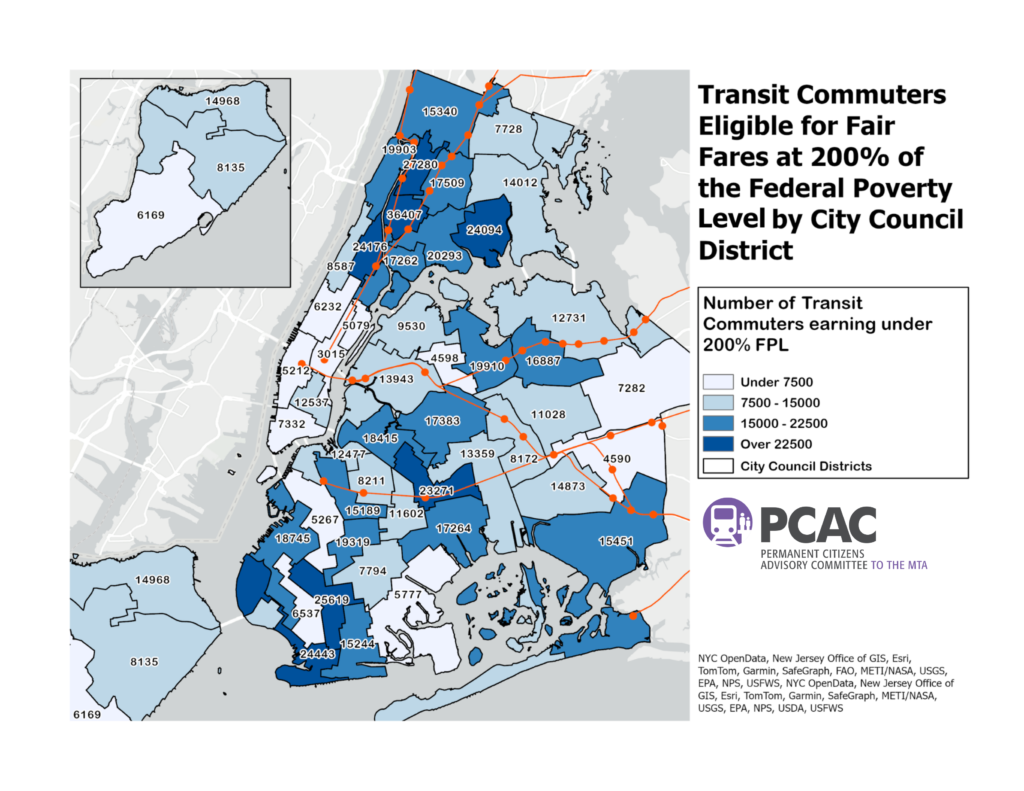
The benefits of expanding Fair Fares to the LIRR and Metro-North within New York City and to 200% FPL are also clear when looking at the number of newly eligible commuters in each Council, Senate, and Assembly district. In the Council districts containing LIRR and Metro-North stations in NYC, a collective 143,567 potential LIRR and 160,892 potential Metro-North riders – for a total of 304,459 – would qualify for Fair Fares at 200% FPL.


National Context:
PCAC analyzed transit providers in the top ten most populous cities in the United States with income-based fare discount programs and found that New York City has both the highest poverty rate and the lowest income threshold at just 145% of the Federal Poverty Level. These results show that the industry standard is to offer a 50% discount to riders making up to 200% of the Federal Poverty Level.
Figure 15: Poverty Rate and Low-Income Fare Discount Threshold, US Transit Agencies
After New York City, the next lowest threshold is Denver’s RTD, whose “LiVE” income-based fare discount program has a threshold at 185% of the Federal Poverty Level. The most generous income-based fare discount in terms of the discount offered also has the highest eligibility: Los Angeles County, which offers 20 free rides per month to Angelenos who make up to 300% of the Federal Poverty Level.
Low-Income Fare Discounts Across US Transit Agencies
| City – Transit Provider | Discount Offered | Eligibility Threshold | Includes Commuter Rail? | Poverty Rate* |
|---|---|---|---|---|
| NYC – MTA | 50% off base fare | 145% of FPL | No | 18.3% |
| LA County – Metro | 20 free rides per month | 300% of FPL | Yes (MetroLink) | 13.9% |
| Austin – CapMetro | 20% off base fare | 200% of FPL | Yes | 11.1% |
| Columbus – COTA | 50% off base fare | 200% of FPL | N/A | 18.1% |
| San Francisco – Muni | 50% off base fare | 200% of FPL | Yes (CalTrain/BART) | 10.4% |
| Seattle – Sound Transit | Varies by mode | 200% of FPL | Yes | 10.1% |
| Denver – RTD | 50% off base fare | 185% of FPL | N/A | 11.8% |
| Boston – MBTA | 50% off base fare | 200% of FPL | Yes | 17.1% |
| Washington DC – Metro | 50% off base fare | 200% of FPL | No (MARC/VRE) | 13.3% |
| Portland – TriMet | 50% off base fare | 200% of FPL | Yes | 12.7% |
Figure 16: Low-Income Fare Discounts Across US Transit Agencies
Of the ten cities analyzed, eight have commuter rail systems operating in the same jurisdiction. Of those, six provide income-based fare discounts on commuter rail and two, New York City and Washington D.C., do not. Unlike the MTA, which oversees New York City Transit, the LIRR, and Metro-North, Washington D.C.’s Metro does not manage the city’s commuter rail services, Maryland Area Rail Commuter (MARC) and Virginia Railway Express (VRE). MARC has one stop within DC city limits, Union Station, and VRE has two. The LIRR and Metro-North have over three dozen commuter rail stations within New York City.
Conclusion:
All around the five boroughs, the data shows that expanding Fair Fares eligibility to 200% FPL would be a game changer for New Yorkers. Increasing access to transit by expanding transit affordability and cutting the fare in half for so many low-income riders mean increasing access to opportunity. Further expanding the Fair Fares program to include the LIRR and Metro-North within New York City – at 200% of the Federal Poverty Level – will help ensure that more riders can afford faster trips on the commuter rail lines that run through Brooklyn, the Bronx, Queens, and Upper Manhattan. The City Council has already shown support for expanding the Fair Fares program to 200% of the Federal Poverty Level. Now, riders are depending on Mayor Adams to come to the table and commit to expanding Fair Fares eligibility in this year’s city budget.
Methodology:
Our maps use the 2019-2023 Five-Year Average American Community Survey (ACS) data compiled for GIS by IPUMS National Historical Geographic Information System. Maps regarding change in Fair Fares eligibility use 150% of the Federal Poverty Level as a proxy for 145% of the Federal Poverty Level, due to the methodology used by the ACS and NHGIS in table C17002: Ratio of Income to Poverty Level in the Past 12 Months. Because of the high cost of living in New York City, the number of people making between 145% and 150% of the Federal Poverty Level is considered negligible for this analysis and only adds to the total number of people who would be newly eligible for Fair Fares.
Sources:
Steven Manson, Jonathan Schroeder, David Van Riper, Katherine Knowles, Tracy Kugler, Finn Roberts, and Steven Ruggles. IPUMS National Historical Geographic Information System: Version 18.0 [dataset]. Minneapolis, MN: IPUMS. 2024. http://doi.org/10.18128/D050.V18.0
Debipriya Chatterjee and Emerita Torres. Community Service Society. When You Can’t Afford the Fare. New York, NY. 2024. https://smhttp-ssl-58547.nexcesscdn.net/nycss/images/uploads/pubs/031324_UHT2023_Transit_Brief_V6.pdf
